
Paragliding in winter from St. Moritz
Duration: 55 minutes or 1 hour

8 Activities
Filter
Better than 4.5 stars
Better than 4 stars
Better than 3.5 stars
Better than 3 stars
No Rating

Duration: 55 minutes or 1 hour

Duration: 2 hours
Why book with Swiss Activities?

Duration: 3 hours

Duration: 3 hours

Duration: 3 hours
Validity: All day
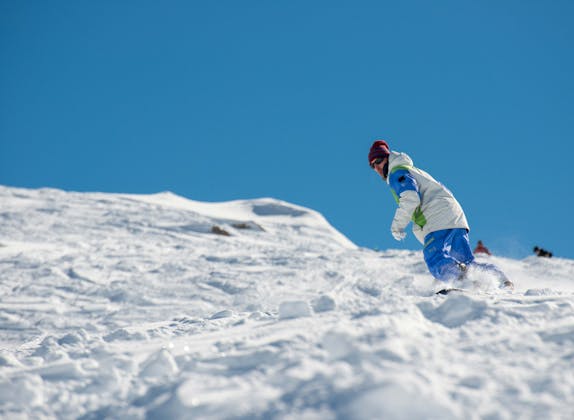
Duration: 3 hours

Duration: 5 days

Duration: 5 days

Adventure
High demandDuration: 55 minutes or 1 hour
booked 19 times

Adventure
Duration: 2 hours
booked 12 times
Why book with Swiss Activities?

Course
Duration: 3 hours
booked 7 times

Tour
Duration: 3 hours

Ticket
High demandDuration: 3 hours
booked 47 times

Course
Duration: 3 hours

Course
Duration: 5 days

Course
Duration: 5 days
 Typische Engadiner Häuser (Foto: Graubünden Ferien)
Typische Engadiner Häuser (Foto: Graubünden Ferien) Ausblick auf Engadiner Seen (Foto: Engadin Tourismus)
Ausblick auf Engadiner Seen (Foto: Engadin Tourismus)The valley, which is about 80 km long, is divided into the Upper Engadine and the Lower Engadine. The border between the Upper and Lower Engadine is marked by the stream "Ova da Punt Ota", which flows into the Inn between Cinuos-chel in the municipality of S-Chanf and Brail.
The Upper Engadine extends from Maloja to Cinuos-chel and is characterized by the lake district with Lake Sils, Lake Silvaplana, Lake St. Moritz and Lake Champferer. The landscape is more open than in the Lower Engadine and is subject to the annual color change of the larch forests
The highest Engadine village lies at 1800 m.a.s.l. on the Maloja Pass between Bergell and the Upper Engadine. The village served as home and inspiration for the famous artist Giovanni Segantini. Also the artist Giovanni Giacometti - Alberto Giacometti's father- was artistically active here. Today, exhibitions, concerts and readings are still inspired by its spirit.
Strictly speaking, this place has two names: Sils Maria and Sils Baselgia. Friedrich Nietzsche once described this village as the "loveliest corner of the earth". Albert Einstein, Charlie Chaplin, David Bowie, Thomas Mann and other artists followed Nietzsche's travel advice. Sils is mostly traffic-free and showcases impressive 16th- and 17th-century houses.
Swiss Activities Tip:
 Radfahren am Silsersee (Foto: Switzerland Tourism Martin Maegli)
Radfahren am Silsersee (Foto: Switzerland Tourism Martin Maegli) Silsersee im Herbst (Foto: Switzerland Tourism Andreas Gerth)
Silsersee im Herbst (Foto: Switzerland Tourism Andreas Gerth)St. Moritz is known worldwide for its top hotels, its lifestyle and a comprehensive year-round sports offering. This trendy resort on Lake St. Moritz brings glamour to the Engadine mountains as a luxurious vacation spot. At the same time, the historic center continues to exude its charm. Numerous destinations in the Engadine, including the nearby lakes of Silsersee and Silvaplanersee, can be easily reached from here.
 Bergdorf St. Moritz (Foto: Graubünden Ferien Gian Giovanoli)
Bergdorf St. Moritz (Foto: Graubünden Ferien Gian Giovanoli)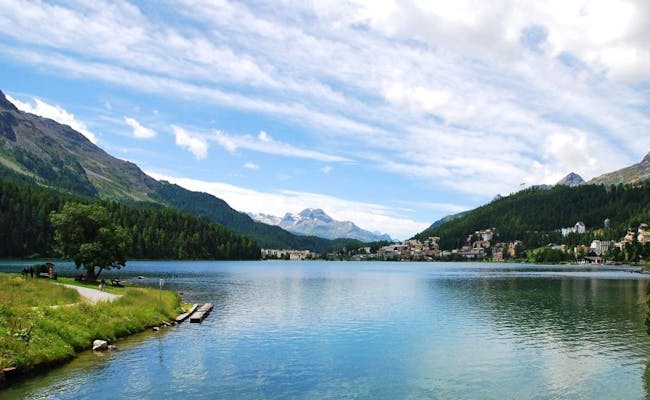 See bei St. Moritz (Foto: Seraina Zellweger)
See bei St. Moritz (Foto: Seraina Zellweger)Pontresina is located at the foot of the Bernina Pass. Traditional Engadine stone houses with beautifully decorated facades characterize the village, which is also known for its many hotels from the Belle Époque. Numerous excursions can be made from Pontresina. Whether it's a ride on the Rhaetian Railway over the Bernina Pass into the Puschlav, an alpine high tour on Piz Palü, or a visit to the crystal-clear Lago Bianco.
The sun-kissed village of La Punt was awarded the title of "Swiss Village of the Year" in 2021. The historic and notable houses contributed to this honor. A bridge connects La Punt with Chamues-ch and served as an important traffic hub and trading place at the foot of the Albula Pass. Today, La Punt is more of a quieter place with good opportunities for biking, road cycling, or inline skating. In winter, winter hiking trails and cross-country ski tracks are groomed.
This small municipality with only 230 inhabitants is home to the largest castle complex in the Upper Engadine. The castle ruin Guardaval was built in the 13th century and is the most remarkable feature of Madulain.
The village is an oasis in the Maloja area. Quiet and idyllic, located by the Inn, you will find time for walks, bike tours, or horseback riding trips. Here too, typical Engadine houses and a Romanesque daily culture await you.
 Landschaft von Madulain (Foto: Engadin Tourismus)
Landschaft von Madulain (Foto: Engadin Tourismus) Städtchen Madulain (Foto: Engadin Tourismus)
Städtchen Madulain (Foto: Engadin Tourismus)The village of Zuoz is considered the most beautiful in the Upper Engadine with its intact Romanesque village character. Mysterious alleys and proud patrician houses invite to discovery tours. Despite a great sense of tradition, Zuoz offers a wide range of leisure activities and with the highest coffee roasting plant in Europe, culinary delights are also proudly represented.
 Dorfkern Zuoz im Sommer (Foto: Engadin Tourismus)
Dorfkern Zuoz im Sommer (Foto: Engadin Tourismus)  Dorfkern Zuoz im Winter (Foto: Engadin Tourismus)
Dorfkern Zuoz im Winter (Foto: Engadin Tourismus) The Lower Engadine extends from S-Chanf to the border village of Martina. Together with Val Müstair and Samnaun, the Lower Engadine forms the district of Inn.
Zernez is known as the gateway to Switzerland's only national park. Numerous hiking trails start here into this beautiful protected area for hikes of one or several days. Furthermore, the visitor center of the national park is located in Zernez, which houses all conceivable information. Zernez is also an ideal starting point for exploring the border triangle of Switzerland - Italy - Austria or the Münstertal valley.
Susch is a typical Engadine village, known as a traffic junction at the foot of the Flüela. A main attraction of the village is the Muzeum Susch. Located on the site of a medieval monastery, the museum has opened its doors since 2019. Existing structures have been carefully restored and combined with new additions.
 Susch Dorfkern (Foto: Graubünden Tourismus)
Susch Dorfkern (Foto: Graubünden Tourismus) Muzeum Susch (Foto: Graubünden Ferien Stefan Schlumpf)
Muzeum Susch (Foto: Graubünden Ferien Stefan Schlumpf)A rich cultural offer awaits you in Lavin, whose village was rebuilt with Italian influences after the fire of 1869. Would you like to enjoy a piece of Bündner Nusstorte or a pear bread and then visit a theater performance? Then Lavin is the right place for you.
Guarda is the showcase village in the Engadine in terms of tradition and innovation. The home of the Schellen Urslis is situated 300 meters above sea level on a sunny terrace. Guarda was awarded the Wakker Prize in 1975 for its well-kept village appearance. This pretty village is a real treasure chest that shines with the sun.
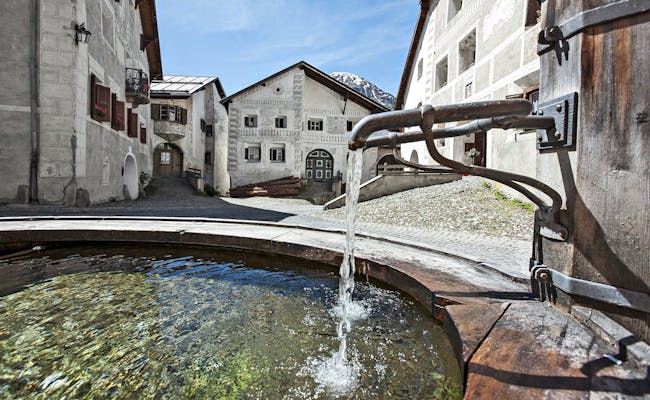 Guarda Dorfzentrum (Foto: Graubünden Ferien Andrea Badrutt)
Guarda Dorfzentrum (Foto: Graubünden Ferien Andrea Badrutt) Wiese bei Guarda (Foto: Graubünden Ferien Marco Badrutt)
Wiese bei Guarda (Foto: Graubünden Ferien Marco Badrutt)In terms of Rhaeto-Romanic language and living culture, Ardez is the model village in the Engadine. Many stately farmhouses have been renovated and placed under protection. The houses in Ardez are characterized by features such as oriels, arched entrance doors, stone pine parlors and deep window alignments. In addition, sgraffito is an integral part of the local architecture. This is the name of the handicraft that adorns Engadine houses.
Like so many Engadine villages, Scuol is known for its massive stone houses decorated with sgraffito. But the real feature of Scuol are the twenty mineral water springs that rise here. Ten of them are used for drinking cures, the thermal bath and carbonic acid mineral baths. Thus Scuol has developed into a true wellness oasis in the Engadine. But also for outdoor activities of all kinds the village is a wonderful starting point all year round.
 Dorfzentrum Scuol (Foto: Graubünden Ferien Petra Greifova)
Dorfzentrum Scuol (Foto: Graubünden Ferien Petra Greifova) Thermalbad in Scuol (Foto: Graubünden Ferien Andrea Badrutt)
Thermalbad in Scuol (Foto: Graubünden Ferien Andrea Badrutt)A peculiarity of Sent are the curved roof gables, also called Senter Giebel. This roof form was brought to Sent at the end of the 18th century by craftsmen from the Inn valley in western Tyrol.
The village is situated in a panoramic and sunny position above Scuol. An important feature of Sent is the imposing village fountain in the center of the village square. This is where life happens and if you want to get an impression of the Romanesque daily life, a stay in Brunnen Nähe is ideal for this.
 Senter Dachgiebel (Foto: Graubünden Tourismus)
Senter Dachgiebel (Foto: Graubünden Tourismus)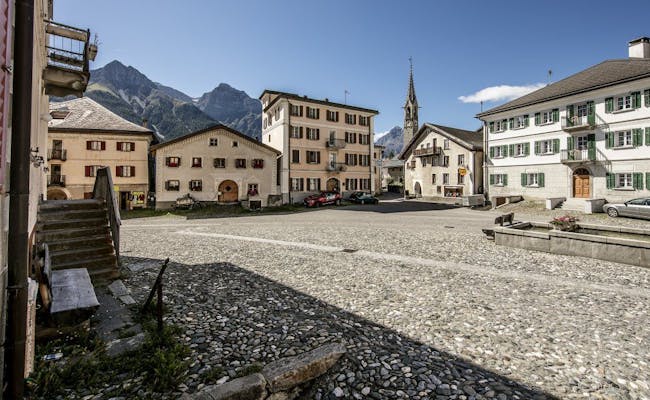 Dorfzentrum von Sent (Foto: Graubünden Tourismus)
Dorfzentrum von Sent (Foto: Graubünden Tourismus)Tschlin is an idyllic village at the entrance of the Lower Engadine, which belongs to the most beautiful Swiss villages. It is known for its beer brewery and the typical terraced landscapes.
The label "Bun Tschlin" stands for about 30 businesses and their products. Tschlin beer is probably the best known product from the range.
The landmark of the Lower Engadine was built in the 11th century by the lords of Tarasp. Several changes of ownership and sieges have seen and survived Tarasp Castle since then. The inventor of Odol, August Lingner, found the castle in desolate condition in 1900 and purchased it without further ado. He spared no effort to rebuild the castle until he died suddenly shortly before completion
Freshly renovated, the castle passed to the Grand Duke Ernst Ludwig of Hesse. In 2016, artist Not Vital took over the castle and made it open to visitors year-round. Since then, Not Vital has been adding new sculptures, such as the "Moon in the Lake" and the "House to Watch the Sunset." He has changed as little as possible about the interior in the castle. During the guided tour of the castle, you will learn in detail what Lingner and Not Vital have made of the castle.
 Schloss Tarasp (Foto: Graubünden Tourismus)
Schloss Tarasp (Foto: Graubünden Tourismus) House to watch the sunset (Foto: Graubünden Tourismus)
House to watch the sunset (Foto: Graubünden Tourismus)The artist Not Vital was born in Sent in 1948. The term international artist applies to him in the truest sense. Not only because he has lived and worked in many countries. His "House to watch the sunset" is a lookout tower that is to be erected on five continents. There is already a tower in Brazil and Niger, and since 2018 now also in Tarasp
The Leaning Tower of St. Moritz is one of the world's most (unintentionally) inclined towers. It is 33 meters high and has a slope of 5.5 degrees. Thus, it is even more leaning than the most famous of all leaning towers in Pisa.
The tower originally belonged to the church of St. Maurice, built in the 13th century, which was demolished in 1893. The tower received more stability through numerous renovations and the heavy bells were removed to relieve the burden already at the end of the 19th century. You can learn more about the history during your visit on the information boards on site.
Near Maloja there is a collection of 36 glacier mills that is unique in Europe. The first seven glacier mills were discovered in 1882 during the construction of the Belvedere Tower. An excursion to the glacier mills is worthwhile not only for the information on their origin but also for their beautiful location in the middle of the protected high moor. The lookout tower at Belvedere Castle lets your gaze wander over the Upper Engadine and into the Bergell. The tower is open from June to October between 10:00 a.m. and 7:00 p.m. Admission is free.
 Belvedere Turm in Maloja (Foto: Graubünden Ferien Stefan Schlumpf)
Belvedere Turm in Maloja (Foto: Graubünden Ferien Stefan Schlumpf) Gletschermühlen bei Maloja (Foto: Engadin Tourismus)
Gletschermühlen bei Maloja (Foto: Engadin Tourismus)Hiking in the National Park:
Switzerland's only national park is located in the Engadine and is a paradise for nature and wildlife observation. At an altitude between 1400 and 3200 m.a.s.l., the park can be explored thanks to a network of trails of about 100 km. Of course, you must not forget provisions, hiking equipment and binoculars
Swiss Activities Tip:
Before your hike, visit the National Park Center in Zernez to gather and ask for all the important information about the National Park. You can also find out more about the National Park here
Wildlife watching:
Guided excursions increase your chances to see animals and learn a lot about them. For example, about the red deer, the bearded vulture or the pine jay, the symbolic animal of the National Park, which can also be found in the logo of the National Park. The National Park Center in Zernez also focuses especially on offers for families and children
Overnight stay in the National Park:
The only overnight accommodations are offered by the Chamanna Cluozza - which can be reached on foot from Zernez in three hours or from the Ofen Pass - and the Hotel Parc Naziunal il Fuorn, located on the Ofen Pass road.
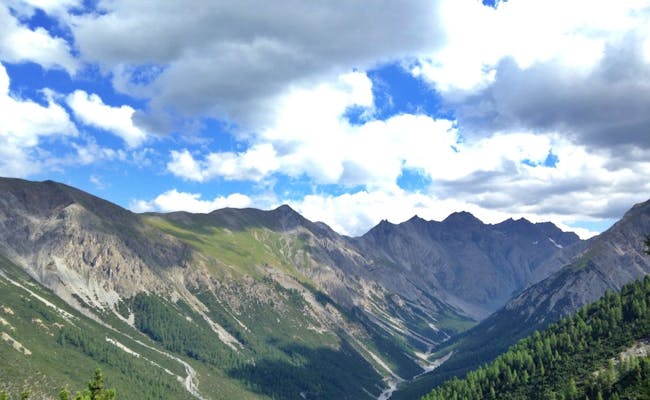 Schweizerischer Nationalpark
Schweizerischer Nationalpark Geführte Wanderung Nationalpark (Foto: Graubünden Ferien Nicola Fürer)
Geführte Wanderung Nationalpark (Foto: Graubünden Ferien Nicola Fürer)The area around Sur En near Scuol offers a wealth of opportunities for a day or several days. The gateway to Sur En is a 60-meter-long wooden bridge. It is the longest existing and passable wooden bridge in Graubünden. Immediately after the bridge lies the campsite with the restaurant Sper la Punt. The restaurant is the ideal starting point for various activities:
Sculpture Path: Each year, dozens of national and international artists come to Sur En to create a sculpture over the course of a week. They usually make these from larch or marble. During this week, the scent and sound of chainsaws dominate the green area by the Inn. The objects are then installed in the forest around the campsite and are free to view. The circular path leads to the hamlet of Sur En and returns along an asphalt road to the restaurant Sper la Punt.
Rope Park: Just a minute away from the restaurant, the trees are connected by wire ropes to a rope park. Since a storm in 2020, the park has been under reconstruction and currently offers four child- and family-friendly courses. Since 2022, the park is being expanded to nine courses and shines in a new splendor.
Limestone Kiln Chalchera Sur En: This limestone kiln, built in 1913, was restored in 1988 and has since been fired up several times to keep this old craft alive.
Hiking Val d’Uina: About 200 meters after the wooden bridge, you reach the actual hamlet of Sur En. From here, the path steadily rises until after about two hours the hiking trail leads through a spectacular 600-meter-long rock gallery. The hike can be continued to the Italian border and to the Sesvenna Hut. Alternatively, after the gallery, you can climb to the Lai da Rims mountain lake plateau and continue hiking to the Lischana SAC hut.
 Lärchen im Engadin (Foto: Engadin Tourismus)
Lärchen im Engadin (Foto: Engadin Tourismus) Ausblick beim Val d'Uina (Foto: Graubünden Tourismus)
Ausblick beim Val d'Uina (Foto: Graubünden Tourismus)S-charl is one of the most remote places in Switzerland and can only be reached by horse-drawn carriage or touring skis in winter. Even in the snow-free months, the approach by bike, car or post bus is spectacular. In the upper section, it feels like you're driving through a canyon
Only 3 km before S-charl is the entrance to Val Mingèr, which is in the national park. The trail leads up to "Sur il fuoss" at 2315 m.a.s.l. with a magnificent view above the tree line. The tour is a classic national park experience. Have you ever spotted ibex or chamois or heard the roaring deer during the rutting season?
Shortly before the village you pass the Schmelzra, the place where silver and lead used to be mined and which made S-charl a mining settlement. The museum Schmelzra is dedicated not only to mining but also to the bear. For 100 years the area was bear-free until 2005 when a specimen reappeared. There is also more bear on the adventure trail "Senda da l'uors".
The hamlet of S-charl itself is car-free. For a rest or refreshment, two restaurants invite you, which also offer rooms. Bikers are welcome here and enjoy a well-deserved break before continuing along the stream. The route leads past God Tamagur, the highest Swiss stone pine forest in Europe, over the Pass da Costainas at 2250 m.a.s.l. and down to Lü in the Münstertal.
 Flussbett S-charl(Foto: Graubünden Ferien Andreas Meyer)
Flussbett S-charl(Foto: Graubünden Ferien Andreas Meyer) Schmelzra mit Bärenweg (Foto: Graubünden Tourismus)
Schmelzra mit Bärenweg (Foto: Graubünden Tourismus)The Bernina Express crosses the Alps as the highest railroad line and is operated by one of the five large and well-known Swiss panorama trains. The Bernina line starts in St. Moritz, then climbs up the Bernina Pass with a gradient of up to 70 per mille and reaches the top of the pass at Ospizio Bernina at 2253 m.a.s.l. It descends to Poschiavo via Alp Grüm and Cavaglia with its interesting glacier mills.
If you want to see palm trees as well as the glaciers of the alpine massif on the same day, a trip with the Bernina Express to Tirano is a good idea.
 Bernina Express Zuglinie (Foto: Swiss Travel System)
Bernina Express Zuglinie (Foto: Swiss Travel System) Haltestelle Ospizio Bernina
Haltestelle Ospizio BerninaIn the thermal springs in Scuol you can bathe in mineral water. Several indoor and outdoor pools, a steam bath, a sauna area and the Roman-Irish bath make the "Bogn Engiadina" the spa and wellness center in the Lower Engadine.
 Thermalbad Scuol Outdoor (Foto: Graubünden Ferien Andrea Badrutt)
Thermalbad Scuol Outdoor (Foto: Graubünden Ferien Andrea Badrutt) Thermalbad Scuol Indoor (Foto: Graubünden Ferien Andrea Badrutt)
Thermalbad Scuol Indoor (Foto: Graubünden Ferien Andrea Badrutt)The remote valleys of Bergell, Puschlav or Münstertal are easier to explore from nowhere than from Engadin.
If you travel over the Bernina Pass to Puschlav, you can stop off at the Camera Obscura on the way, pay a visit to the glacier mills at Cavaglia or take a hike to Lake Saoseo.
If you drive over the Maloja Pass into Bergell, you have the opportunity to visit the chestnut groves in Soglio on the high trail. Romantic walks through historic villages and untouched nature along the Via Bregaglia are also waiting for you.
During an excursion over the Ofen Pass into the Münstertal, the UNESCO Biosphere Reserve Val Müstair is on the way. If you want to add a culinary touch to your visit, the "Chatscha culinarica", a culinary treasure hunt, offers you the opportunity to do so.
 Bergdorf Soglio (Foto: Graubünden Ferien)
Bergdorf Soglio (Foto: Graubünden Ferien) Kloster Müstair (Foto: Graubünden Ferien Gianni Bodini)
Kloster Müstair (Foto: Graubünden Ferien Gianni Bodini)The Graubünden Pass Total and the Graubünden Pass South are valid throughout the Engadin. With the Graubünden Pass you are flexible when traveling. You can choose whether you want to travel on 2 days within a week or on 5 days within 2 weeks. With the Graubünden Pass as a whole, you can also travel in the North Zone of the Graubünden Pass.
Mountain peaks offer a beautiful backdrop from a distance. But maybe you'd like to stand on a mountain peak yourself and enjoy the view from above? In the Engadine, there are dozens of ways to do just that. Be it with the practical assistance of mountain railroads or entirely under your own steam with good hiking boots on your feet.
The Diavolezza is on the one hand the starting point for alpine adventures and on the other hand a panoramic terrace with a magnificent view of the peaks of the Bernina Group. Alpinists take aim at Piz Palü or Piz Cambrena from here
Via the Pers and Morteratsch glaciers, a glacier tour leads down over 1100 meters in altitude to the Morteratsch train station.
At a proud 3066 m.a.s.l. at Sass Queder lies the highest fireplace in Switzerland. Firewood is available at the top station of the Diavolezza cable car. From the station, the ascent to the fireplace takes about 30 minutes.
A hike of about two hours, which is also suitable for children, leads from the top station of the cable car to Lake Diavolezza and on to the bottom station. With a bit of luck you can even see ptarmigans on this hike.
 Seilbahn Diavolezza (Foto: Graubünden Ferien)
Seilbahn Diavolezza (Foto: Graubünden Ferien) Bergrestaurant Diavolezza (Foto: Engadin Tourismus)
Bergrestaurant Diavolezza (Foto: Engadin Tourismus)The Corvatsch, a 3451 meter high mountain of the Bernina Group, is a popular mountain destination near Silvaplana for summer and winter activities.
The local mountain of St. Moritz faces south, which makes it very popular, especially in winter, thanks to its exposure to the sun. Corviglia became famous thanks to the Winter Olympics, which were held twice in St. Moritz in the first half of the 20th century. Here you will find 160 kilometers of ski slopes in winter and various bike trails and hiking trails in summer.
 Biken in Corviglia (Foto: Graubünden Ferien Markus Greber)
Biken in Corviglia (Foto: Graubünden Ferien Markus Greber) Winterwandern in Corviglia (Foto: Engadin Tourismus)
Winterwandern in Corviglia (Foto: Engadin Tourismus)The first tourist mountain railroad in Graubünden was established on Muottas Muragl in 1907. The funicular covers the approximately 700 meters in altitude from Punt Muragl to Muottas Muragl in a nostalgic manner. Paragliders, mountain bikers and hikers get off at the mountain station. In summer, the hike to the Segantini Hut is popular, in winter the fast-paced toboggan run
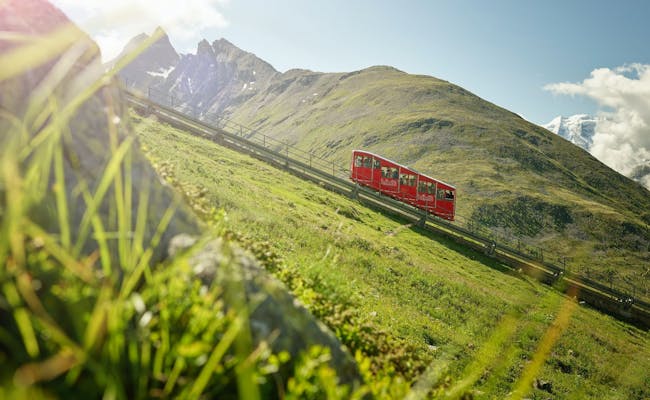 Bergbahn Muottas Muragl (Foto: Graubünden Ferien Stefan Schlumpf)
Bergbahn Muottas Muragl (Foto: Graubünden Ferien Stefan Schlumpf) Wandern in Muottas Muragl (Foto: Graubünden Ferien Andrea Badrutt)
Wandern in Muottas Muragl (Foto: Graubünden Ferien Andrea Badrutt)The Inn and its waters are present throughout the Engadine. Every drop of rain that falls in this region joins the Inn at some point. The source of the Inn is located on the Lunghin Pass above Maloja. This unique place has an important significance as a triple watershed
Towards the east, the water flows into the Inn and via the Danube into the Black Sea. To the northwest, the water flows into the Rhine, which finally flows into the North Sea. Raindrops that choose to flow southwest ultimately travel toward the Mediterranean Sea
Lake Sils, Lake Silvaplana and Lake St. Moritz are three well-known Engadine lakes. They offer practically the whole spectrum of water sports. Of course, they are also suitable for simply cooling off or taking a walk.
The Silsersee invites you to Europe's highest course navigation or to sail with the strong Maloja wind. Lake Silvaplana, on the other hand, is the undisputed Mecca for kite- and windsurfers. And in winter, polo is played on the frozen Lake St. Moritz.
 Aussicht auf den Silvaplanersee (Switzerland Tourism Christof Sonderegger)
Aussicht auf den Silvaplanersee (Switzerland Tourism Christof Sonderegger) Silvaplanersee im Herbst (Foto: Switzerland Tourism Stefan Gruenig)
Silvaplanersee im Herbst (Foto: Switzerland Tourism Stefan Gruenig)Sheltered from the wind and sun, Lej Marsch is easily accessible by car. This, with the picnic area and a small beach on the north shore, is one reason why it attracts many families.
Situated not far from Lej Marsch, Lej Nair can only be reached on foot. The mighty Piz Corvatsch is reflected in its water when there is no wind. If you want to bring your sausage, there are several fireplaces here.
Lake Champfèr is only separated from Lake Silvaplana by a peninsula. The cold and clear water probably attracts more fishermen than bathers. If you would like to practice fishing, appropriate licenses are available from the municipal police or from the Office for Hunting and Fishing of the Canton of Graubünden.
A beautiful mountain lake near the Maloja Pass is the Lägh da Cavloc. The lake can be reached in all seasons on foot or also by mountain bike. The barbecue area is equipped with firewood by the municipality
In the restaurant Cavloccio, which is only open in summer, you can taste regional specialties. On the alp Cavloc it is also possible to taste and buy the local goat cheese Mascarplin.
Hikers can continue up to the Forno hut or walk back to Maloja via the Lägh da Bitabergh. The lake is often one of the first to freeze in winter and is therefore particularly popular for skating.
Lake Staz is located in a high moor just under an hour's walk from Pontresina or from St. Moritz. The water in the moor lakes is warmer than in the big lakes, which makes it an ideal bathing lake in this nevertheless often cooler area.
 Stazersee im Sommer (Foto: Engadin Tourismus)
Stazersee im Sommer (Foto: Engadin Tourismus) Stazersee im Winter (Foto: Switzerland Tourism Christof Sonderegger)
Stazersee im Winter (Foto: Switzerland Tourism Christof Sonderegger)Paragliding is the perfect opportunity to take off and enjoy. In addition to its popularity with individual paraglider pilots, passenger flights have also become a regular part of mountain sports activities in the Engadine. Depending on the season, courage and preference, on the one hand there are quieter flights in winter or in the evening. On the other hand, longer cross-country and thermal flights or even acrobatic flights await.
The following places are particularly suitable for paragliding flights:
From Muottas Muragl you can admire the Engadine and its lakes at sunset. From Christmas to Easter you can book a tandem flight with the delta glider or with the paraglider in St. Moritz. Take off with or without skis on the Corviglia and land on the frozen lake. On the Motta Naluns above Scuol, paraglider pilots regularly take off with their guests.
 Gleitschirmfliegen Engadin im Winter (Foto: Engadin Tourismus)
Gleitschirmfliegen Engadin im Winter (Foto: Engadin Tourismus) Gleitschirmfliegen Engadin im Sommer (Foto: Engadin Tourismus)
Gleitschirmfliegen Engadin im Sommer (Foto: Engadin Tourismus)The network of hiking trails in the Engadine is said to be over 580 km in the Upper Engadine alone. For you, this means that you will need your hiking boots. Because no matter where you are in the Engadine, hiking is always a good option.
Swiss Activities hiking tips:
Val Sinestra near Sent: Over several suspension bridges the path leads from the art nouveau spa house Val Sinestra through the landscape of the year 2011 to Zuort and further towards Griosch to the hamlet of Vnà.
Via Engiadina: This multi-day hike along the Via Engiadina in the Lower Engadine leads in six varied daily stages from Zernez to Vinadi. The high trail leads you on the sunny side of the valley to historic villages, through fragrant pine and larch forests, across lush meadows and past gurgling streams.
Knee pads: From Samedan via Val Champagna to Muottas Muragl, this trail overcomes a difference of 1100 meters in altitude. The hike leads over the high alpine stone desert of Piz Vadret, before you see the entire Engadine panorama at the highest point. Down into the valley you can take the Muottas Muragl cable car, which is easy on the knees.
 Wandern im Engadin (Foto: Graubünden Ferien Stefan Schlumpf)
Wandern im Engadin (Foto: Graubünden Ferien Stefan Schlumpf) Holzweg im Engadin (Foto: Graubünden Ferien Andrea Badrutt)
Holzweg im Engadin (Foto: Graubünden Ferien Andrea Badrutt)The difficulty levels for mountain hiking trails are described in more detail in the SAC Hiking Scale. Before your hike, it makes sense to familiarize yourself with this scale. It is divided into 6 grades.
A popular Engadine activity is to wander through the woods in the morning dew, taking in the silence and the air, and picking mushrooms. It is the perfect combination of forest bathing and picking. Please note that there is always a closed season from the 1st to the 10th day of the month and a maximum of 2 kg of mushrooms may be collected per person per day.
The Engadine is an extremely mountain bike friendly region. Over 400 km of pure riding pleasure await you here. For many years, the sport has been promoted through cooperation with mountain railroads, sports stores and hotels. A lot of effort is put into the construction, signposting and maintenance of trails. The mountain passes are particularly popular with racing cyclists, who prefer asphalt roads to paths over hill and dale.
 Mountainbiken im Engadin (Foto: Graubünden Ferien Thilo Brunner)
Mountainbiken im Engadin (Foto: Graubünden Ferien Thilo Brunner)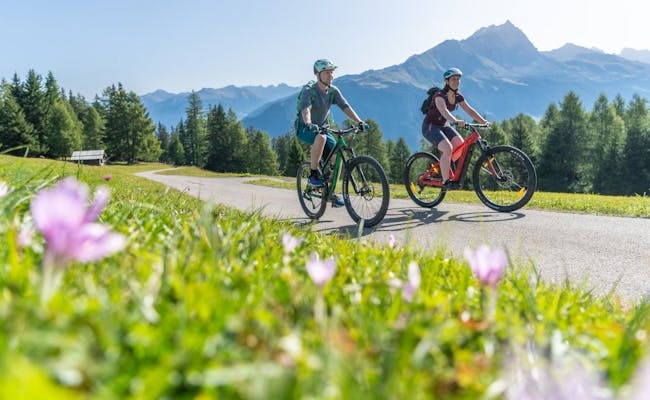 Velofahren im Engadin (Foto: Graubünden Ferien Mattias Nutt)
Velofahren im Engadin (Foto: Graubünden Ferien Mattias Nutt)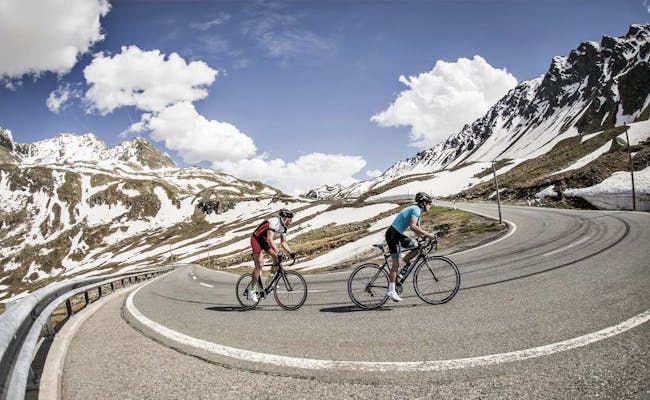 Rennvelofahren im Engadin (Foto: Graubünden Ferien Daniel Geiger)
Rennvelofahren im Engadin (Foto: Graubünden Ferien Daniel Geiger) Palpuognasee am Albulapass
Palpuognasee am AlbulapassThe Inn Cycle Path runs on 4 stages and about 110 km in length through varied terrain and through numerous Engadine villages. Half of the path is paved with asphalt and the other half is natural. It is signposted as Schweizmobil Route 65 and is ideal for cycling on a gravel bike.
The Bernina Express Route leads from Samedan to Poschiavo and is suitable for bikers in good physical condition. The start of the tour at Samedan is technically very easy. From Pontresina the route climbs slowly on a natural road to Ospizio Bernina. On the descent to Poschiavo it can get rough and racy. Once in Poschiavo, you can take the train back to Ospizio Bernina and then follow the single trails to Samedan.
 Downhill Biken im Engadin (Foto: Graubünden Ferien Markus Greber)
Downhill Biken im Engadin (Foto: Graubünden Ferien Markus Greber) Mountainbike Albulatrail (Foto: Graubünden Tourismus)
Mountainbike Albulatrail (Foto: Graubünden Tourismus)Rope parks have gained great popularity in recent years. They offer a good opportunity to be brave and on your own between the trees. At the same time, there are experienced supervisors on site who are responsible for safety and can provide assistance if necessary. The rope parks each have different levels of difficulty and follow routes at different tree heights. In the Engadine, there are rope parks in Sur En, S-Chanf and Pontresina
 Seilpark S-chanf (Foto: Engadin Tourismus)
Seilpark S-chanf (Foto: Engadin Tourismus)  Kinder im Seilpark S-chanf (Foto: Engadin Tourismus)
Kinder im Seilpark S-chanf (Foto: Engadin Tourismus) In the Engadine there are several opportunities where you can practice the perfect tee shot in the fresh mountain air. The 18-hole golf course in Samedan is the oldest in Switzerland. In Zuoz Madulain a varied 18-hole course opened in 2003 and St. Moritz is home to one of the highest golf courses in Europe. It has 9 holes and is characterized by short distances
 Golfplatz Samedan (Foto: Graubünden Ferien)
Golfplatz Samedan (Foto: Graubünden Ferien) Golfplatz St. Moritz Kulm (Foto: Graubünden Ferien)
Golfplatz St. Moritz Kulm (Foto: Graubünden Ferien)On a Vitaparcours you combine agility, dexterity and strength on usually 15 posts distributed in the great outdoors. Whether during the given exercises or jogging between the posts, the important thing here is the movement in the fresh air. Information boards and parking spaces are standard at Vitaparcours.
In the Engadin you will find a wide variety of courses:
White-water rafting became popular in the 1980s and was introduced as a commercial leisure activity, making it known as Rafting. The Engadine, and the Inn River in particular, is high on the popularity scale for whitewater sports enthusiasts in Europe. In this region there are a variety of rafting offers for cautious beginners as well as for experienced rafters who are after a more challenging tour.
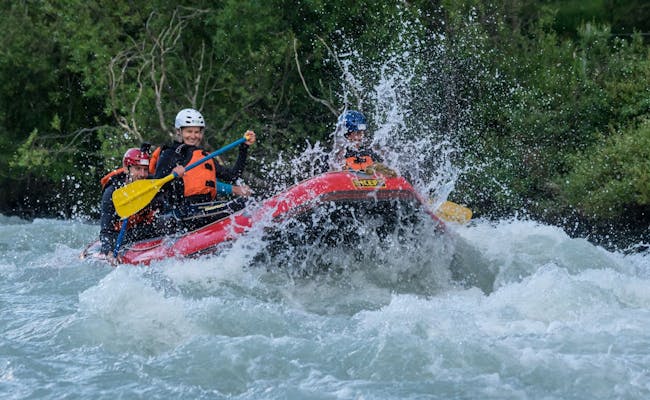 Wildwasser Rafting Engadin (Foto Engadin Outdoor Center)
Wildwasser Rafting Engadin (Foto Engadin Outdoor Center) Rafting Gruppe Engadin (Foto Engadin Outdoor Center)
Rafting Gruppe Engadin (Foto Engadin Outdoor Center)The Giarsun Gorge, which falls into category 4 on the whitewater scale, is often called the best rafting tour in Switzerland. Tours through the gorge are conducted by several providers and last about five hours including instruction, changing, transfer to the one-boat place and back
On the river, you spend about two hours marveling and paddling along the stretch between Susch and Ardez. It is a real rafting experience and offers an impressive adventure on a medium level. For this tour you must be 14 years old and be able to swim well
The rafting section near Scuol is a bit calmer than the Giarsun Gorge, which is why this tour is usually chosen as the entry tour in the morning in the combination tours offered But don't worry: even here you won't stay dry while navigating the key sections with adventurous names like "Northwall" or "Terminator".
For children over 8 years old, there are quieter sections of the Inn River or its tributaries in the Engadine that are scenically beautiful and offer a lot of rafting fun. The tours are also family-friendly from a financial point of view
 Rafting im Engadin (Foto: Engadin Outdoor Center)
Rafting im Engadin (Foto: Engadin Outdoor Center) Familien Rafting Engadin (Foto: Engadin Outdoor Center)
Familien Rafting Engadin (Foto: Engadin Outdoor Center)Engadin is the perfect place for a winter vacation. Every imaginable sport or activity involving snow and ice is favored by the low temperatures in the Engadine winter. The flat valley floor, with valleys stretching along its sides and mountains rising up, encourages a wide variety of winter activities. In the Engadine, for example, it is easy to go cross-country skiing horizontally and ice climbing vertically on the same day.
350 kilometers on 88 slopes in nine ski areas await snowboarders and skiers in the Engadine, which is considered to have guaranteed snow. This is due on the one hand to the altitude and on the other hand to the low temperatures.
 Snowboarden im Engadin (Foto: Graubünden Ferien)
Snowboarden im Engadin (Foto: Graubünden Ferien) Skifahren in St. Moritz (Foto: Graubünden Ferien Andrea Badrutt)
Skifahren in St. Moritz (Foto: Graubünden Ferien Andrea Badrutt)For walkers and hikers, many trails are prepared in winter in the Engadine - some of them also in the ski resorts. The fresh, clear air and the crunching under your soles accompany you on the signposted winter hiking trails.
Snowshoeing is becoming increasingly popular. There is something magical about the feeling of moving through untouched deep snow. There are guided snowshoe tours - even by moonlight - that are highly recommended.
If you intend to go off the marked trails, it is important to obtain the necessary knowledge about wildlife protection, orientation, avalanches and weather. Likewise, the appropriate equipment must not be missing.
Swiss Activities Tips:
Muottas Muragl: Here there is a shorter marked route of 3 km as well as a longer one that is 7 km. In this area you also have the opportunity to participate in an organized full moon snowshoe tour.
Pontresina: The quiet and fairytale-like Stazerwald trail starts at the cross-country skiing center in Pontresina. In the Stazerwald you are also allowed to deviate from the marked path and leave your tracks in the untouched snow in criss-cross fashion.
The medium-difficulty Morteratsch Trail starts at the railroad crossing in Morteratsch and leads for just under 3 km to the glacier and back.
From Guarda, a moderately difficult trail leads to Alp Sura and back. The path is not prepared, but it is signalized. Allow about three hours for this hike.
Please inform yourself in advance about the rules of conduct for snowshoeing and about safety. The SwitzerlandMobility app is helpful for planning and on the way, as it shows your position as well as the route.
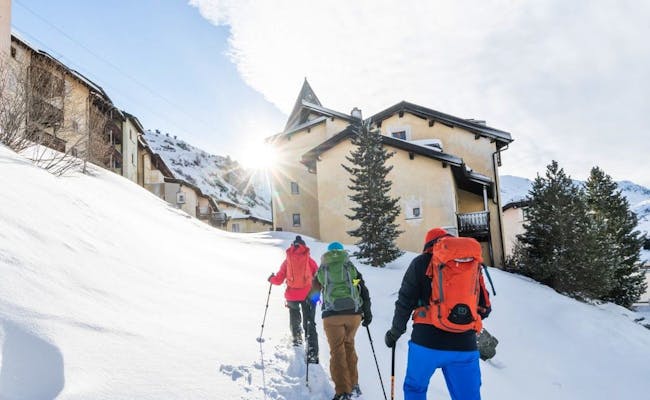 Schneeschuhlaufen im Engadin(Foto: Graubünden Ferien Mattias Nutt)
Schneeschuhlaufen im Engadin(Foto: Graubünden Ferien Mattias Nutt)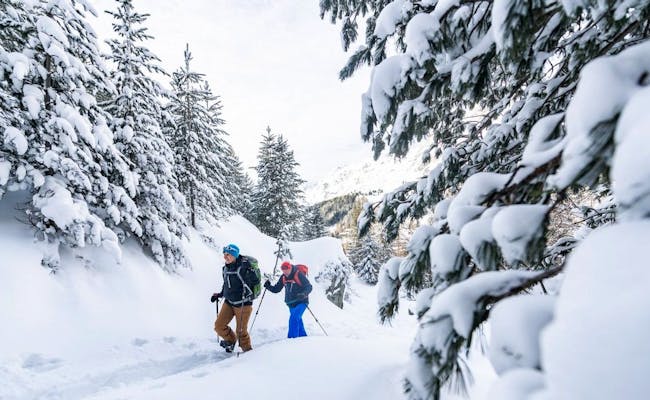 Schneeschuhlaufen im Wald (Foto: Graubünden Ferien Mattias Nutt)
Schneeschuhlaufen im Wald (Foto: Graubünden Ferien Mattias Nutt)Cross-country skiing is an excellent whole-body workout. In addition to strengthening the circulation and muscles, many cross-country skiers appreciate the meditative aspect of this endurance sport. The Engadine promotes your health on 230 kilometers of cross-country trails and is also the host of the most famous cross-country event in Switzerland - the Engadine Ski Marathon.
Swiss Activities Tips:
 Langlaufen in Celerina (Foto: Graubünden Ferien Romano Salis)
Langlaufen in Celerina (Foto: Graubünden Ferien Romano Salis) Langlaufen in Celerina mit Burg (Foto: Graubünden Ferien Christof Sonderegger)
Langlaufen in Celerina mit Burg (Foto: Graubünden Ferien Christof Sonderegger)The fact that ice skating and ice hockey have been popular sports in the Engadine for a long time does not come as a surprise. Temperatures average -9 degrees Celsius in winter, which clearly favors moving around on the ice.
The Engadin ice trail is located near Scuol. It is opened every year from the middle of December and follows a route of 3 km along the river Inn. To "walk" with the ice skates is a very special experience and is very different from the well-known ice field, where you usually move in circles
The entrance fee for adults is 11 CHF, while children pay 7 CHF. Skates can be rented on site for 5 CHF
The Madulain ice trail starts at the Werkhof, where parking is also available. Sunny on the open valley floor, the trail runs for one kilometer along the Inn River. The entrance to this ice trail is free and you have to bring your own skates.
The ice arena in St. Moritz is open all year round. Besides figure skating or field hockey, you will also have the opportunity for curling and curling.
You can find other ice rinks and natural ice rinks in the Engadine at the following locations:
It is a special experience when the Engadine lakes are black frozen. If the weather conditions allow it, you can skate your laps on the natural ice. You will find information about the accessibility of the ice directly on the spot. Lakes that are often passable in winter are Lago Bianco on the Bernina Pass or Lake Cavloccio near Maloja.
 Eishockey auf gefrorenem See (Foto: Engadin Tourismus)
Eishockey auf gefrorenem See (Foto: Engadin Tourismus)  Eisweg Madulain (Foto: Engadin Tourismus)
Eisweg Madulain (Foto: Engadin Tourismus)Pontresina is the ice climbing center in the Engadine. In addition to the natural ice formation, the gorge of Pontresina is also worked with water. This creates ice walls every year, which offer optimal conditions and variety for ice climbing. Courses and equipment are also offered in Ponstresina
At the Corvatsch mountain station, an approximately 50-meter-high ice wall is also prepared.
 Eisklettern im Engadin (Foto: Switzerland Tourism Christof Sonderegger)
Eisklettern im Engadin (Foto: Switzerland Tourism Christof Sonderegger) Ausrüstung zum Eisklettern (Foto: Engadin Tourismus)
Ausrüstung zum Eisklettern (Foto: Engadin Tourismus)For many, the journey to the Engadine is already a highlight. A particularly eventful journey awaits you on the Albula Pass with its narrow, difficult-to-cross sections of road. Absolutely worth seeing and not far from the pass road is the picturesque and crystal clear Palpuognasee, one of the most beautiful mountain lakes in Switzerland
A maintenance base is available for winter maintenance of the Bernina Pass. It contains a special attraction: a camera obscura - the archetype of the photographic camera. This camera obscura can be walked through and is located on the top floor of the silo
The light from the surroundings falls through a small hole into the windowless room. This projects the landscape into the room as if through the lens of a camera. Of course, this method works best in fine weather. The new building was also awarded the Beton21 architecture prize.
 Camera Obscura Gebäude(Foto: Engadin Tourismus)
Camera Obscura Gebäude(Foto: Engadin Tourismus) Camera Obscura (Foto: Engadin Tourismus)
Camera Obscura (Foto: Engadin Tourismus)The God Tamangur is the highest continuous Swiss stone pine forest in Europe As in the nearby national park, no trees are felled here and fallen trees are left lying. Nature takes care of itself here.
Besides the stone pines, some of which are several hundred years old, larches and junipers also grow in the undergrowth. As a natural forest reserve surrounded by a moor conservation area, the area is unique in Switzerland. The God Tamangur is best reached on a hike from S-Charl to Lü. You can practically get to these two starting points by Postauto.
 Arvenwald God Tamangur (Foto: Graubünden Tourismus)
Arvenwald God Tamangur (Foto: Graubünden Tourismus)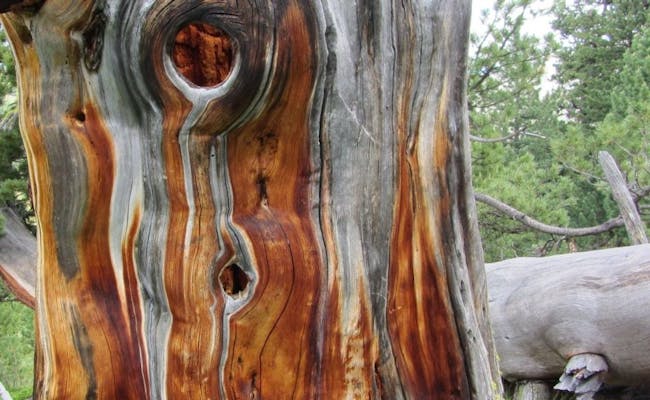 Arve im God Tamangur (Foto: Graubünden Tourismus)
Arve im God Tamangur (Foto: Graubünden Tourismus)The Swiss stone pine (lat. Pinus Cembra) is also popularly called Arve, Arbe or Zirbe. The Swiss stone pine is an evergreen conifer from the pine family. As a distinguishing feature, the Swiss stone pine produces five needles per bud, while the Scots pine produces two.
The wood of the Swiss stone pine is an important raw material for many Engadine products. It is soft and easy to work and it has a fine aromatic scent. That is why it has always been used for the paneling and the ceilings of the Engadine living rooms "Stüva" and for the production of furniture.
The fir jay contributes to the spread of the Swiss stone pine. The bird with the 4 centimeter long beak feeds on the seeds of the Swiss stone pine, which it buries in thousands of hiding places for storage. Most of the hiding places it finds again. From the rest germinate young stone pines in the spring
The stone pine forms mycorrhizal symbioses with various fungi. Without these, the Swiss stone pine would hardly be viable at high altitudes. The partners include the fly agaric, which is also readily found in birch trees, the Swiss stone pine boletus or the red-brown lactarius.
 Führung zur Arve (Foto: Engadin Tourismus)
Führung zur Arve (Foto: Engadin Tourismus) Essen in der Arvenstube (Foto: Engadin Tourismus)
Essen in der Arvenstube (Foto: Engadin Tourismus)This trip is one of a special kind in the Engadine. At the Corvatsch-Furtschellas valley station, you buy a voucher booklet that is valid for the ascent to the middle station as well as for three restaurant visits along the freely selectable hiking route. You can enjoy breakfast or a starter in the mountain restaurant La Chüdera, the main course in the Hotel Sonne Fex and dessert in Sils-Maria in the Hotel Seraina.
Sturdy shoes and a water bottle are advisable on this two to four hour tour. From Fex Platta you have the option of being chauffeured to dessert in Sils-Maria by horse-drawn carriage.
The price for the voucher booklet, which includes meals and the ride on the mountain railroad, is CHF 60.
Do you have a favorite village in the Engadine? Then a village tour is a great opportunity to learn more about it. In almost every Engadine village, guided tours are offered by locals who will love to show you their home.
 Bergdorf Ardez (Foto: Graubünden Freien Marco Hartmann)
Bergdorf Ardez (Foto: Graubünden Freien Marco Hartmann)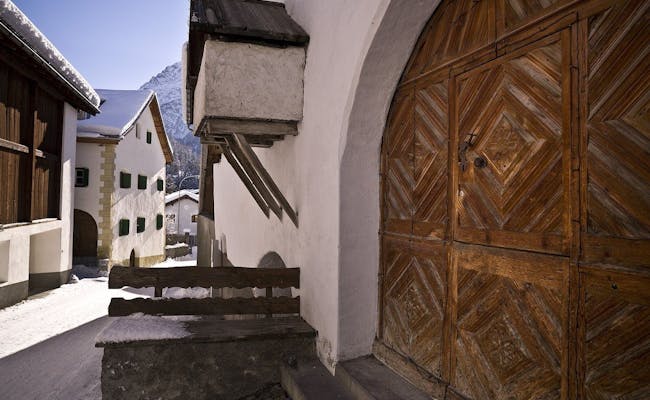 Gasse in Scuol (Foto: Graubünden Ferien Andrea Badrutt)
Gasse in Scuol (Foto: Graubünden Ferien Andrea Badrutt)Val Roseg is a popular destination in summer and winter, although not a hidden gem, it is a solid recommendation for all ages and all seasons. Whether you are walking, riding in a horse-drawn carriage, or mountain biking, the most famous dessert buffet in the Engadine at the Roseg Glacier restaurant awaits you with its homemade delicacies.
If you find yourself passing by a village fountain with two taps in Scuol, then you are at the source. Here, mineral water flows directly from the faucet, allowing you to fill your bottle and experience the freshness of this Engadine mineral water.
The following mineral springs supply their water to the Scuol village fountains:
In the Upper Engadine, especially in and around St. Moritz, there are a number of international major events that take place annually.
 Snow Polo Cup St. Moritz (Foto: Engadin Tourismus)
Snow Polo Cup St. Moritz (Foto: Engadin Tourismus) White Turf Engadin (Foto: Engadin Tourismus)
White Turf Engadin (Foto: Engadin Tourismus)Take a look behind the facades of outstanding buildings from various time periods. The Opendoors Engadin takes place at the end of June. Admission is free.
In the Lower Engadine, there are a whole series of sports and smaller cultural events. Here you can find the current events.
Two highlights from the calendar are:
It is March 1st, which means it is Chalandamarz. The ringing of cowbells, crackling whips, and children in blue shirts with scarves and red pointed hats are the hallmarks of this traditional event. It is an old custom that marks the beginning of spring.
At the Bergbierfestival Tschlin, Swiss mountain brewers who produce with mountain spring water and above 1000 m.a.s.l. meet every autumn. For non-brewers, there is a hiking tasting.
The Arven menu at the Hotel Gasthaus Krone is awarded by the Michelin Guide and has 15 Gault-Millau points. Chef Andreas Martin conjures up delicious dishes from Arven nuts, providing a culinary experience of a special kind.
 Gasthaus Krone La Punt (Foto: Engadin Tourismus)
Gasthaus Krone La Punt (Foto: Engadin Tourismus) Essen im Krone La Punt (Foto: Engadin Tourismus)
Essen im Krone La Punt (Foto: Engadin Tourismus)The mountain restaurant Alp Languard is easily accessible by chairlift from Pontresina and offers hearty food with a view of the Piz Palü and the Bernina massif. The delicious pizzoccheri for lunch is not to be missed.
Open only in summer from June to October daily from 09:00 to 17:00
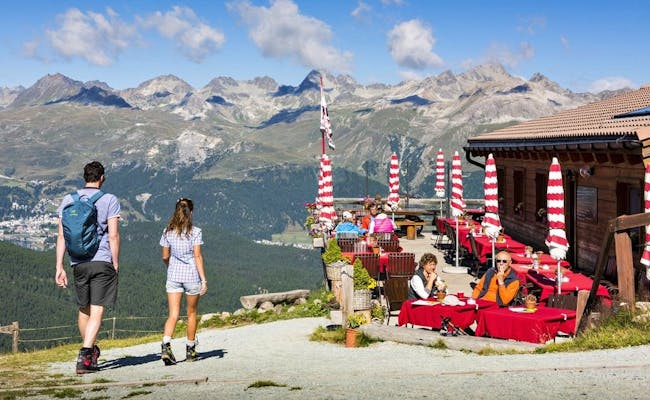 Berggasthaus Alp Languard (Foto: Engadin Tourismus)
Berggasthaus Alp Languard (Foto: Engadin Tourismus) Desser in der Alp Languard (Foto: Engadin Tourismus)
Desser in der Alp Languard (Foto: Engadin Tourismus)The Hotel Edelweiss is located in the immediate vicinity of Lake Sils, the Nietzsche House, the Fex Valley and the Corvatsch-Furtschellas ski area. Cultural evenings and concerts are also organized here. Regional as well as international dishes are served to you in a traditional Arvenstube.
In the Hotel Edelweiss you can find the Grand Restaurant, the Restaurant Arvenstube, the hotel bar and a sun terrace
The restaurant is open in summer from the beginning of June until mid-October and in winter from mid-December until the beginning of April.
The Hotel Restaurant Veduta serves the best Grisons dishes. The host runs the business in the third generation and has a hunting patent. The restaurant offers you a good opportunity to try a local game dish or Graubünden specialties like capuns or a delicious Graubünden barley soup.
The iconic, rich Nussorte can be found in almost every pastry shop in the Engadine. Made of a sweet shortcrust pastry, the cake is filled with a mixture of nuts, caramel, honey and cream. The Engadin nut cake is part of Switzerland's culinary heritage and is known far beyond the country's borders. But it clearly tastes best in its native environment.
 Engadiner Nusstorten Stück (Foto: Graubünden Ferien)
Engadiner Nusstorten Stück (Foto: Graubünden Ferien) Engadiner Nusstorte (Foto: Graubünden Ferien Marco Hartmann)
Engadiner Nusstorte (Foto: Graubünden Ferien Marco Hartmann)The Beverlodge is the first modular wooden hotel in Switzerland and is geared towards athletes. Here you can get tour suggestions and bike maps for your upcoming tour. A workshop and a bike washing area are also available. In winter, you can wax your cross-country skis and then head straight to the trail, which is right in front of the house.
The Berninahaus is located away from the hustle and bustle of the Bernina Pass. The historic building was built in 1515 and renovated with great dedication in 2006.
It is open in the summer and winter season from mid-June to the end of October and from mid-December to the end of April.
Alpenloft Hotel in Sent manages six lofts and two studios in functional design and with different details. On the one hand, you'll find pine wood paneling from the 19th century, and on the other, panoramic windows or even lookout towers in the various lofts. This gives each vacation apartment its own unique character.
The Morteratsch campsite is nestled between streams and ponds in the alpine landscape. In the background the snow-white peaks of the Bernina group shine. The site has a high level of comfort and a modern infrastructure. During the vacation periods we strongly recommend you to book your place in advance.
 Panorama Campingplatz Morteratsch(Foto: Engadin Tourismus)
Panorama Campingplatz Morteratsch(Foto: Engadin Tourismus) Spielplatz bei Campingplatz Morteratsch (Foto: Engadin Tourismus)
Spielplatz bei Campingplatz Morteratsch (Foto: Engadin Tourismus)Arriving by car promises a winding drive over one of the many passes that lead into the Engadine. These include the Julier Pass, the Albula Pass, the Flüela Pass, the Ofen Pass or, coming from the south, the Bernina Pass and the Maloja Pass
A stopover at the top of the pass or at a suitable stopping place often gives you wonderful views of the Swiss mountains with their peaks, lakes, rivers and forests
In winter you should pay attention to which passes are open. You have the best chance at the Julierpass for winter access. Please also bring your snow chains in winter to avoid getting stuck on the road.
As an alternative to the passes, you can load your car onto the train between Klosters and Sagliains. This will save you a winding ride, which can be very advantageous for passengers with a weak stomach.
 Julierpass Marmorerasee (Foto: Graubünden Ferien Nico Schaerer)
Julierpass Marmorerasee (Foto: Graubünden Ferien Nico Schaerer) Flüelapass (Foto: Graubünden Ferien Nico Schaerer)
Flüelapass (Foto: Graubünden Ferien Nico Schaerer)A spectacular journey awaits you by train from Chur on the panoramic train of the Bernina Express. The journey is beautiful and varied. Thanks to the pioneering work in the construction of the Landwasser Viaduct and the many helical tunnels to Bergün, there is never a dull moment during the journey.
The timetables of the Rhaetian Railway are coordinated with the SBB and thus ensure short transfer times in Chur. While a seat reservation is necessary for the panorama train with its large windows, no reservation is necessary in the "normal" carriages and the other trains on this route.
 Landwasser Viadukt (Foto: Graubünden Ferien Andrea Badrutt)
Landwasser Viadukt (Foto: Graubünden Ferien Andrea Badrutt) Bernina Express Zug (Foto: Graubünden Ferien Andrea Badrutt)
Bernina Express Zug (Foto: Graubünden Ferien Andrea Badrutt)Romansh is the fourth national language of Switzerland, spoken mainly in the canton of Graubünden and by only one percent of the Swiss population. Romansh exists in five different dialects and idioms, which have developed due to the remoteness of the valleys - especially in winter
These are:
If you visit the villages of the Lower Engadin, you will quickly notice how strongly the Rhaeto-Romanic language is anchored in everyday life. Be it when you go shopping or when you hear the local children on the street. Rhaeto-Romanic is the language of instruction until the 3rd grade, with German, French, English or Italian following later as foreign languages.
Here you will find some useful links if you want to learn more about Romansh:
Here you can find a list of useful expressions in "Vallader".
| allegra | "grüezi", good day |
|---|---|
| a revair | goodbye |
| bun di | good morning |
| buna saira | good evening |
| buna not | good night |
| bellas vacanzas | happy vacations |
| grazcha fich | thank you very much |
| bun viadi | bon voyage |
| il bogn | the bath |
| l'abitaziun | the apartment |
| la bacharia | the butchery |
| la banca | the bank |
| la butia | the store |
| la furnaria | the bakery |
| la garascha | the garage |
| la posta | the post office |
| l'ospidal | the hospital |
| l'ustaria | the restaurant |
| la via | the street |
| na | no |
| shi/hai | yes |
| s-chüsa | excuse |
| lündeschdi | Monday |
| mardi | Tuesday |
| marcurdi | Wednesday |
| gövgia | Thursday |
| venderdi | Friday |
| sonda | Saturday |
| dumengia | Sunday |
The Engadine is a long high valley that runs between high mountains of the Central Alps. In general, it is characterized by relative dryness. Fog is also much less common here than on alpine slopes.
There are climatic differences between the Upper Engadine and the Lower Engadine. The Upper Engadine is more spoiled by the sun due to its southern slopes. This includes primarily the villages of Maloja (1817 m.a.s.l.) and St. Moritz (1800 m.a.s.l.). Further down the Inn Valley, Pontresina (1780 m.a.s.l.) and Scanfs (1680 m.a.s.l.) also belong to the Upper Engadine.
The high-montane and alpine climate prevailing here is determined by the altitude and alternates with subalpine climate. Although this area is one of the coldest in the Alps in winter, the winter season ends here sooner than in Prättigau, for example. The average snow cover is much lower due to the dryness. In summer, temperatures below 20 degrees Celsius are reached, and in January the lowest temperature is minus 11 degrees Celsius. Precipitation is highest in July with 144 mm; humidity ranges between a pleasant 51 and 67 percent throughout the year.
 Winter im Engadin (Foto: Graubünden Ferien Andrea Badrutt)
Winter im Engadin (Foto: Graubünden Ferien Andrea Badrutt) Sommer im Engadi (Foto: Graubünden Ferien)
Sommer im Engadi (Foto: Graubünden Ferien)The Lower Engadine stretches from Brail (1630 m.a.s.l.) to the border with Austria and is characterized by wild gorges. Essential for the climatic region is the area around Scuol (1290 m.a.s.l.) Here the average snow cover is about 50 centimeters. In summer it is sunny and dry. The temperatures rise up to 23 degrees Celsius in July, in winter minus 8 degrees are possible. At 63 to 78%, humidity is significantly higher than in the Upper Engadine.
| Average Temperature St. Moritz | Average Temperature Scuol | Average Precipitation St. Moritz | Average Precipitation Scuol | |
|---|---|---|---|---|
| January | -6 | -4 | 34 | 32 |
| February | -5 | -4 | 38 | 19 |
| March | -2 | -1 | 47 | 26 |
| April | 1 | 4 | 65 | 22 |
| May | 6 | 8 | 71 | 34 |
| June | 11 | 13 | 80 | 41 |
| July | 14 | 16 | 87 | 36 |
| August | 14 | 16 | 89 | 50 |
| September | 10 | 12 | 59 | 32 |
| October | 5 | 7 | 81 | 34 |
| November | -1 | 1 | 67 | 18 |
| December | -4 | -3 | 34 | 33 |
In the Upper Engadine, there are about 14 foggy days per year. Nevertheless, a special phenomenon can be observed here: A band of clouds moves down from Bergell over the Maloja Pass to St. Moritz. This bad weather phenomenon is also called Maloja snake
On fair weather days, the Maloja wind blows down the valley. It arises because the very steep mountain slopes in Bergell warm up much faster in the morning than the valley. The much warmer air over the Engadine exchanges with the cold air in the Bergell valley and leads to the Maloja wind.
 Nebel im Engadin (Foto: Graubünden Ferien Andera Badrutt)
Nebel im Engadin (Foto: Graubünden Ferien Andera Badrutt) Wetter im Engadin (Foto: Graubünden Ferien Andera Badrutt)
Wetter im Engadin (Foto: Graubünden Ferien Andera Badrutt)Gliders and paragliders like to take advantage of these updrafts. As it progresses, this strong wind then blows downhill in the Upper Engadine. This is rather untypical for such winds. That is why it is also called "contrary wind". Especially in the months from July to October storm-like cool winds occur frequently. The headwind to the Maloja wind is the Brüscha. It blows up the valley depending on the sun. This is due to the effect that the mountains at altitude have a longer solar radiation than the valleys. The Brüscha is rather weak because of the width of the Upper Engadine valley.